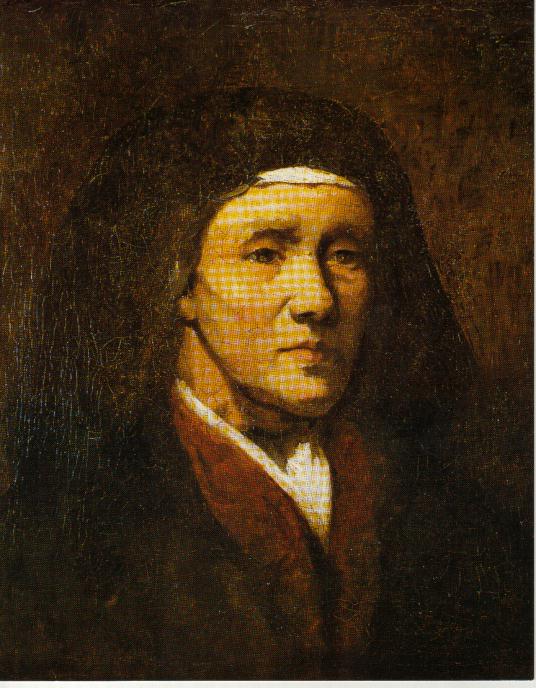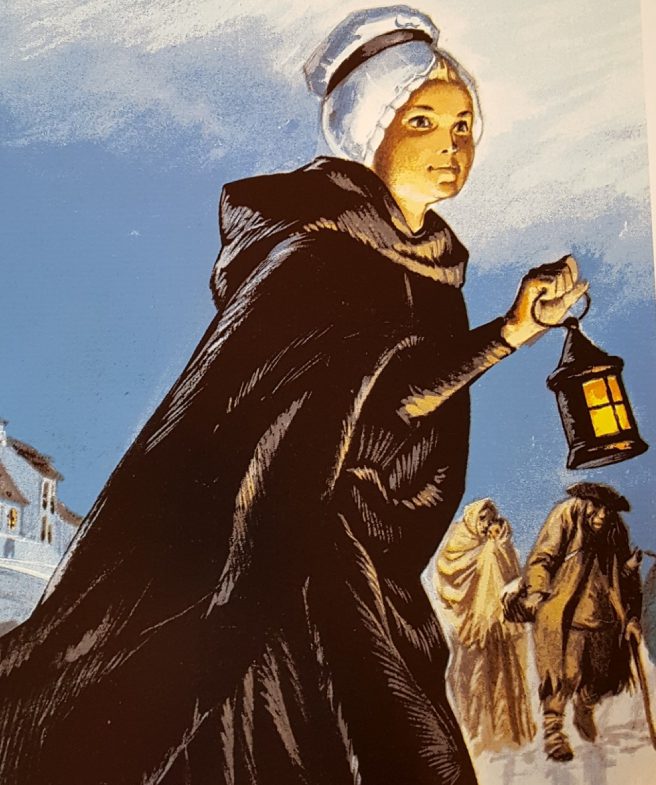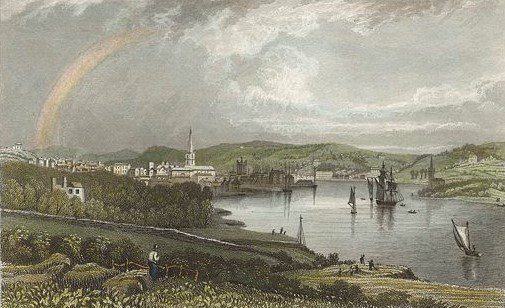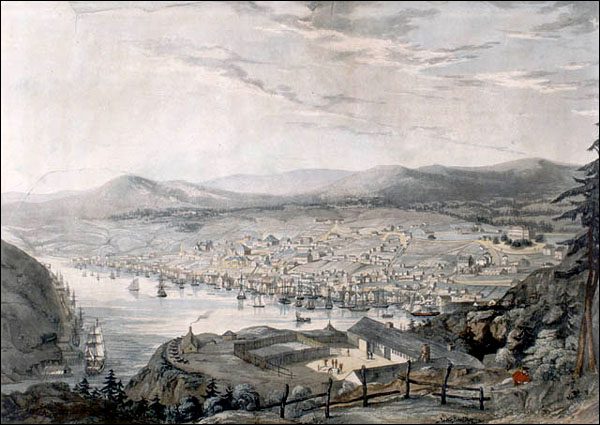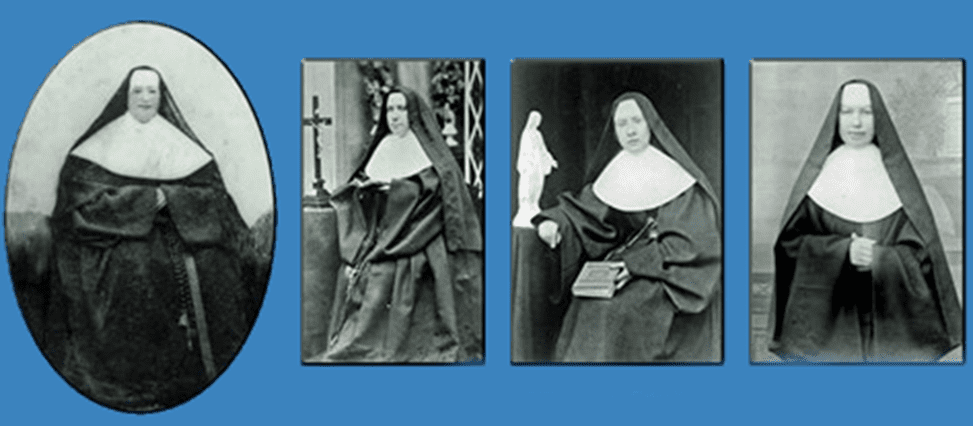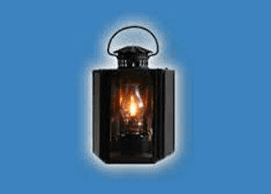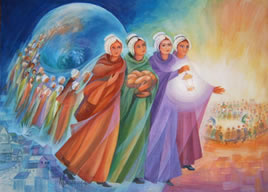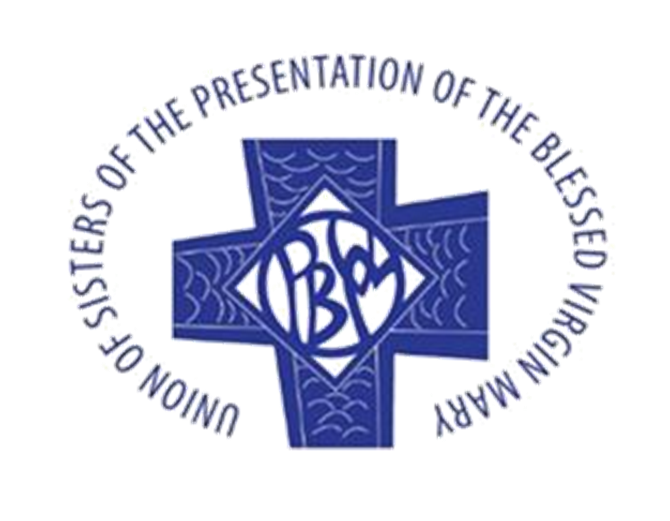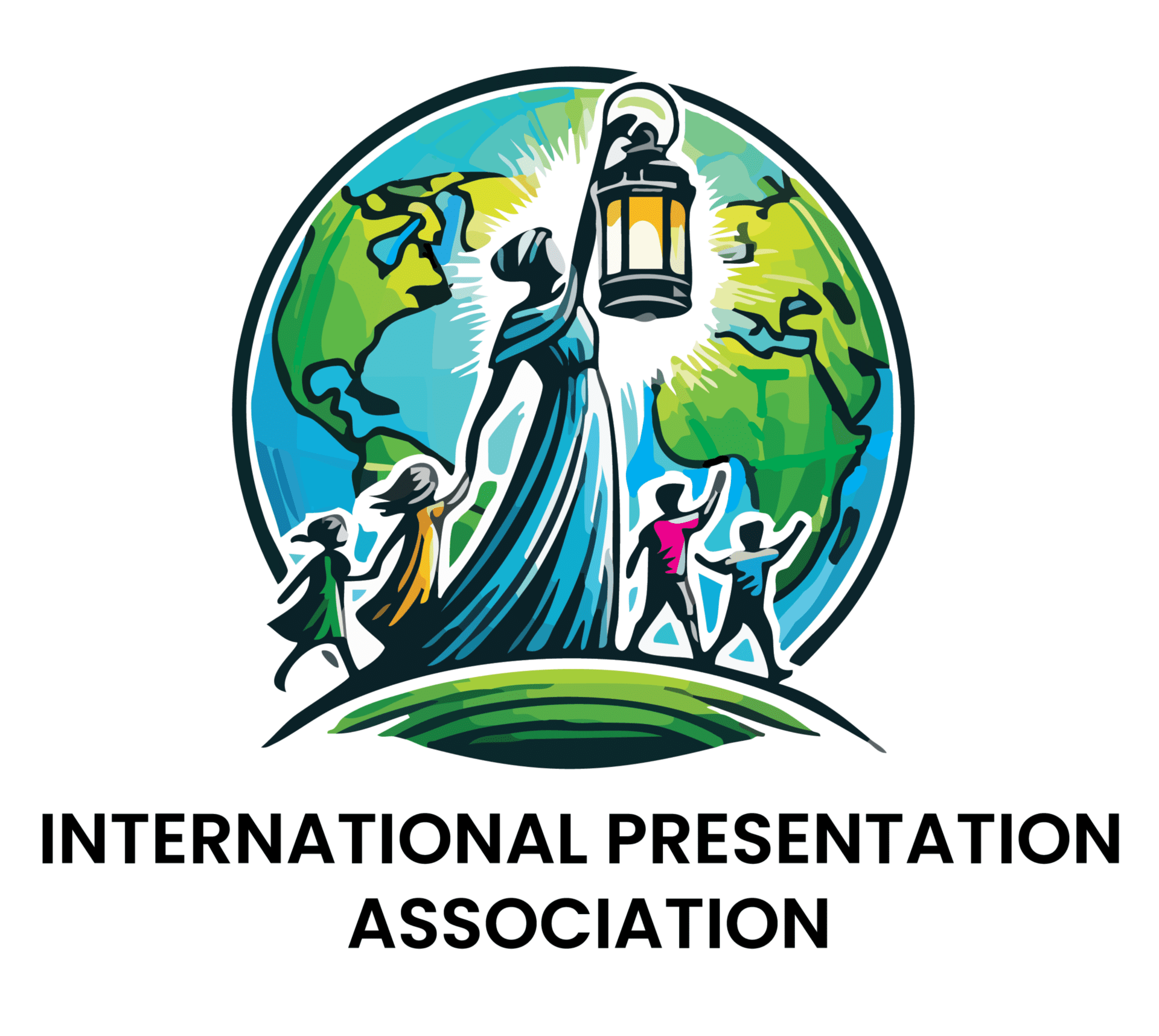Who We Are
We, as Presentation Sisters, are shaped by fidelity to the Gospel as expressed in the mission, charism and spirituality of Nano Nagle. (C2)
Beginnings and Beyond
Nano Nagle – the only portrait known to be painted from life; attributed to James Barry
Click to view an Introduction to Nano Nagle and Her Work, posted by Nano Nagle Place, Cork, Ireland.
The founding of the Sisters of the
Presentation of the Blessed Virgin Mary
In the early 18th century new seeds of God’s evolving dream were planted in the heart of a young Irish woman named Nano Nagle. On Christmas Eve 1775, with a group of like-minded women, Nano Nagle established a religious community that would later become known as the Sisters of the Presentation of the Blessed Virgin Mary (PBVM).
Nano – Her Story Then, Our Story Now
Honora (Nano) Nagle (1718-1784) was born the eldest of seven children to well-to-do parents in Ballygriffin, County Cork. At the time, British Penal Laws denied Irish Catholics and other “dissenters” the right to worship and religious instruction and, as importantly, the political, economic, social and educational rights needed to lift them from mass poverty.
Read more about Nano Nagle
Consequently, Nano had received her earliest education in Ireland’s “hedge schools” – the small, illegal, often outdoor schools set up in the 18th and 19th centuries to secretly educate children of “non-conforming” Irish people. Despite prohibitions on educational travel for Catholics, Nano and her sister Ann were sent in secret to France, with the help of Nagle relatives there, to complete their education. After finishing their schooling, she and Ann enjoyed a busy and glamourous social life in Paris. Returning from one particular party, Nano noticed a group of poor peasants huddled in a church doorway and was struck by the contrast with her privileged life. Something stirred deeply within her as she remembered the plight of her own Irish people. Powerful seeds had been planted in that moment, perhaps quite unbeknownst to her at the time.
After their father’s death in 1746, Nano and Ann returned to Dublin to be with their mother, who sadly died soon after. Dublin, a city in which thousands of Catholics lived in appalling misery and destitution, fired in Ann a deep passion for the poor. Nano, too, was deeply touched while also yearning for the social life of Paris she had left behind so abruptly. One day, Nano inquired of Ann about a length of green silk she had brought from France, dreaming of a new gown suitable for the “society” events she expected to attend, only to find that Ann had sold it to buy food, clothing and medicine for a poor family in distress. Witnessing Ann’s passion for the poor was a turning point for Nano. Ann, too, died shortly after, another turning point for Nano. Overwhelmed by the misery of the poor and feeling hopeless, she returned to France to enter an Ursuline convent. Before long, unsure what lay ahead but haunted by the plight of the Irish poor, on the advice of her spiritual director, Nano returned home permanently, daring all, and committed to doing all that was in her power to do for the vulnerable and disenfranchised.
This time she returned to Cork and her brother Joseph. Despite her privileged background and the risk of imprisonment, at 32 Nano secretly gathered the children of the poor, teaching them catechism, reading, writing and mathematics, as well as other life skills, often outdoors in hedgerows or “hedge schools”. An August 2020 Irish Quarterly Review biographical note cites a letter in which Nano describes her ideas for education, based on France’s lay-language Petites Écoles, and how she wanted the spiritual and temporal welfare of her pupils to be interwoven and to flow naturally together.
Eventually, as word of her work spread, Nano established seven hedge schools, five for girls and two for boys, and established her first school for the poor in 1754 in a rented mud cabin in Cove Lane, Cork, in defiance of the law and initially in complete secrecy, even from her brother. Joseph discovered her secret when a poor man came begging for Nano to accept his child into her school. Angry and afraid at first, knowing full well the potential consequences, Joseph soon became her greatest supporter.
Tireless in service, Nano spent her days teaching children and her nights caring for the sick and elderly, bringing them food, medicine and comfort. Making her way by lamplight, Nano became known as the “Lady of the Lantern.” The lantern has since become the symbol of Presentation Sisters worldwide. Amidst all else, Nano spent long hours in prayer and contemplation, clearly foundational for her life and ministry, and which guided, impelled and sustained her.
Nano was specially dedicated to care for the powerless and vulnerable, especially through education, seeing it as a pathway out of poverty and towards greater self-empowerment. Wanting this work to continue and knowing she alone could not sustain it, in time she gathered other women to form a new society of women religious dedicated to serving Ireland’s poor. Nano Nagle’s small band of women, originally named the Society of Charitable Instruction of the Sacred Heart of Jesus, later became known as the Sisters of the Presentation of the Blessed Virgin Mary.
While Nano’s example inspired several other founders of religious orders in Ireland, her Sisters also established additional Presentation foundations throughout all of Ireland.
Their horizon, Nano’s dream, indeed the evolving dream of God, has expanded to encompass not only all of Ireland, but the world. We are now approximately 2600 strong, in 27 countries and on all but one continent. As Nano herself said, “If I could be of service … in any part of the world, I would gladly do all in my power.”
In 2000 Nano was voted Irish Woman of the Millennium, in recognition of her importance as a pioneer of female education in Ireland. In a 2005 Irish radio poll, she was voted Ireland’s greatest woman ever. Ireland also honoured her with a pair of postage stamps for her Congregation’s 1975 bi-centenary and with a footbridge being renamed for her across Cork’s River Lee.
The Roman Catholic Church officially opened Nano’s cause for canonization in 1984, the bi-centenary of her death. She was declared a Servant of God in 1994. On October 31, 2013 Nano was declared Venerable by Pope Francis – a fitting recognition of her role as a woman of heroic virtue. Today, Venerable Nano Nagle is regarded as one of the great pioneers of Catholic education in Ireland and beyond.
Click to read Nano’s Obituary Notice
Click to read the Nano’s Tomb Inscription
Who truly was this woman? She was so highly acclaimed by so many, and yet a deeply humble servant of the poor. The late Raphael Consedine, pbvm, captures her essence beautifully:
She was a woman who, in her simplicity, dared greatly…dared to let herself be guided by the Spirit of God.
And when He, like some will o’ the wisp on the mountains, led her from the warmth of what was safe and comfortable, out past the four walls of what was “enough” and “reasonable”, away from the security of the familiar, tried and proven, she followed with laughter in her heart.
For she had caught a glimpse of the Divine delight in reversing human logic, in drawing power from weakness, wisdom from folly, life from death. In this lay her strength. This is Nano Nagle.
Raphael Consedine, PBVM
Learn more about Venerable Nano Nagle here.
View the video, Legacy of Nano Nagle, a 300th Anniversary collaboration of NL Presentation Sisters with the North American Conference of Presentation Sisters. This 20-minute video, filmed 31 December 2018, includes reflections by our Sisters Miriam Martin (00:02 and 2:52) and Alice Walsh (10:04), and our Associate, Maxine Sturge (16:57).
Read more: How Presentation spread out from Ireland
In the early 19th Century, Presentation Sisters branched out, establishing communities both east and west of Ireland, often to places with substantial Irish immigration. First, in 1833, four Sisters from the Galway community journeyed to what was then the British Colony of Newfoundland, later to become the tenth province of Canada; soon after, in 1836, came a foundation in Manchester, England. Additional Presentation communities were subsequently established around the globe, with several convents and schools in India, Australia, the West Indies and the United States as early as the end of the 19th Century.
Given the limits of transportation and communication at the time, most Presentation foundations within and outside Ireland were autonomous communities without formal links to their founding houses. Eventually, in 1976, many of these groups and their missions came together to form a new Congregation, The Union of the Sisters of the Presentation of the Blessed Virgin Mary. They have since been joined by other Presentation Communities, from around the world, including our NL Sisters in 2014.
Presentation Sisters now comprise three groupings around the world: Union, The Conference of Presentation Sisters of North America and The Australian Society. While independent of each other on a level of governance, the three groupings continue to share the same charism, mission and spirituality.
In yet another context all groups are also under the umbrella of the IPA or International Presentation Association, founded in 1988 to network the various Presentation congregations and better channel their energies and resources in order to speak and act in partnership with others for global justice, particularly in four categories: women and children, indigenous peoples, the environment/sustainable development and human rights.
The world has changed beyond all imaginings since Nano’s founding of the Presentation Sisters, yet her lantern light continues to guide and inspire the world-wide network of Presentation Sisters, Presentation Associates and Friends of Nano, co-workers and colleagues in Presentation schools and centres, and wherever those inspired by her are working to make the world a more just place. Presentation Sisters world-wide remain dedicated to service to the poor with a special focus on education, social justice and communion with all life.
Presentation NL Story
Waterford Harbour, Ireland, circa 1831, whence the four founding Sisters departed Ireland
(Credit: Waterford Historical Society)
from Ireland
to Newfoundland
with an ocean
in between …
In 1833 four pioneering Sisters from Galway, Ireland – Sisters Bernard Kirwan, Xaverius Lynch, Xavier Molony and Magdalen O’Shaughnessy – carried Nano’s vision and spirit to our own Newfoundland shores. It would seem they were naturally following the path of so many Irish immigrants and keeping alive Nano’s vision of education as a path out of poverty for the powerless and vulnerable.
Bishop Michael Fleming of St. John’s can be credited with inviting the Sisters to Newfoundland. The Irish-born Franciscan visited the Presentation Convent in Galway to discuss a mission to Newfoundland. His choice of Galway was not accidental: the superior there, Mother John Power, was a friend of his and a native of Waterford, a place to which many Irish immigrants in Newfoundland felt a close connection. Bishop Fleming asked for volunteers to establish a school for girls in St. John’s. A boy’s school had already been established, but it was not considered at all suitable for girls and young women. The four Sisters eagerly volunteered. They were to come for a period of two years, after which the Bishop had guaranteed Mother John their return trip should the venture not meet with success. The Sisters came to Newfoundland and never looked back. Indeed, at least 99 other young Irish women later followed in their footsteps, some becoming Sisters. Soon, young Newfoundland women began to join them.
Click here to listen to Sister Patricia Tracey’s Song telling in song her story of our beginnings … to the tune of The Rose of Tralee. Click HERE for the Lyrics and the transcript.
The four founding Sisters of Presentation’s Newfoundland Congregation: L-R Mother Bernard Kirwan, Sister Magdalen O’Shaughnessy, Sister Xavier Molony, Sister Xavierius Lynch
Read More about the NL Foundresses' Journey
Having left Ireland to cross the Atlantic in August of 1833, the four Sisters arrived on September 21st after enduring 25 days at sea in perilous storm conditions that damaged their vessel, The Ariel, and “shredded” its sails. When land finally came into view, they were faced with yet one last challenge: thick fog made it impossible to safely navigate through the narrow entrance to the sheltered port of St. John’s, stranding them just outside for another three days.
Their journey had taken so long that, with no word of them having been received in Ireland, they were presumed lost at sea, their vows burned as was the tradition and a funeral service held. One can only imagine the joy and excitement of the Galway Community when their first letters arrived telling of their incredible adventures at sea, the wonderful welcome they had received and the amazing warmth of the people and this new land they had now begun to call home. About their journey, Sister Magdalen O’Shaughnessy wrote:
On the third day after we left Ireland we had a storm. One of the masts were broken and some others damaged. We were not much frightened because we were almost regardless of what was going on we were so deadly sick . . . we soon had another storm . . . it lasted 36 hours … the sails were torn to pieces … the waves were monstrous high. You may be sure there was not a saint in the calendar not invoked during this violent storm. I had a feeling almost amounting to certainty that God would not abandon us . . . I did not regret for a moment the step we had taken. (Unpublished Presentation Archive Material)
In one of her first letters home, Sister Xaverius Lynch recalled the joyful welcome the Sisters had received on arrival in St. John’s:
It was a most grand sight. We crossed the harbour in a small boat and when we came near the shore there were crowds of small boats full of people, the banks and hill were crowded and as soon as the boat the Bishop and we were in arrived there was nothing to be heard but shouts of joy and acclamations . . . we drove off to the Bishop’s house followed by crowds and now and then there were shouts of joy and “You are welcome” and this scene did not end until we got into the house. (Unpublished Presentation Archive Material)
The beauty of the land itself impressed the sisters. In Sister Xavier’s words:
We were agreeably surprised at the appearance of the country which we heard so terrible an account of. All around there is to be seen hills and mountains, perfectly green, interspersed with houses, green fields and small gardens… In fact you would never be tired with the scenery. We are delighted with it and every day we discover fresh beauties. (Unpublished Presentation Archival Material)
By October 21st they had resourcefully adapted the site of a former tavern, auspiciously named “The Rising Sun”, as both convent and school. This first school welcomed over 450 girls and young women, but soon proved inadequate for the large number of students. The Sisters moved to a succession of eight different sites, one on what is still known as Nunnery Hill. By 1844 they had built a new convent and school on Long’s Hill, which housed six Sisters and had classroom space for over 1000 children; tragically, the structure was destroyed just two years later by the devastating City-wide fire of 1846.
One of the refugees is thought to have brought the fire into the convent in some smoldering blankets, unnoticed by anyone until the fire in the town was almost out and the convent suddenly began to burn. So rapid was the spread of flames that all the historical Archives belonging to the order were lost. The Sisters had barely time to save themselves and the throng they were sheltering before their convent was in ruins. (Paul O’Neill, The Oldest City, Vol. II, p. 790)
As a result, our Sisters were hosted by the Mercy Sisters, who had arrived in 1842, until they could move into their new convent and school, forging a close, collaborative relationship between the two Congregations that has continued to evolve and deepen over the years. Catherine McAuley, the Foundress of the Sisters of Mercy, had actually done her initial training in Religious Life with the Sisters of the Presentation in Ireland. Presentation Convent and School, officially opened in 1853, remains largely unchanged; located next to the Basilica of St. John the Baptist, it is now the site of our Presentation Motherhouse, Administration Offices and Archives.
Since 1833 our Sisters have faithfully carried out Nano’s mission to provide enabling supports for the poor and vulnerable, adapting to the needs of the changing times, touching the lives of tens of thousands of Newfoundlanders & Labradorians and expanding, too, beyond our own shores.
Teacher training, academic learning, spiritual development/religious education and a deep appreciation for the arts and music have been central to our Presentation education ministry, engaging students, teachers and parents, as well as the wider community. The contribution of our Sisters to the arts and music in particular is a time-honoured legacy that lives on in the lives of so many students who have become teachers, performers and artists, and advocates for the arts.
After the province’s transition to a non-denominational education system at the end of the 20th Century, Newfoundland & Labrador Presentation Sisters transitioned away from working directly as school administrators and educators to partnerships with the wider community, often supporting education in other ways. While some former Presentation schools continue in use as part of the provincial K-12 education system, other properties, including some of our convents, have been repurposed in collaboration with community partners to help address emerging needs, including an Emergency Children’s Shelter in the 1990s, spirituality and neighbourhood community centres and, most recently, affordable housing for seniors and an end-of-life Hospice Centre.
Nano’s vision had birthed a response that was daring, and both broad and penetrating. Her spirit, the spirit of these first four women and those who followed them, continues to guide us as we give new expression to ministry for these ever-changing and increasingly challenging times.
Fusion with Presentation Sisters World-Wide
We Walk One: saying yes to the greater community of life
We invite you to journey back in time to a more recent momentous occasion in our NL Presentation story. On November 14th, 2014, with profound joy and gratitude, we announced the fusion of our Congregation of the Sisters of the Presentation of Newfoundland and Labrador with the world-wide Union of Sisters of the Presentation of the Blessed Virgin Mary, effective November 1, 2014. We had now became part of the larger global Presentation Congregation.
Like so many other Presentation foundations outside Ireland, the Presentation Sisters of Newfoundland and Labrador had been established as an autonomous Congregation. In fusing with Union, we became the NL Unit of Union, now part of an international, multi-cultural Congregation, united by our common vision and charism, and with our Congregation Leadership Team (CLT) based in Ireland. It was as if reconnecting with our very roots.
Therein began the next chapter of our evolving story.
It is indeed fitting that our Fusion with Union was effective as of All Saints’ Day, November 1st, as we remembered and celebrated all those who have gone before us, those on whose shoulders we stand. Their spirit had been carrying us to this new moment; they had taught us about integrity, courage, fidelity and availability for mission. It was their faith and trust and their willingness to risk that encouraged us to say yes to the unknown future that continued to beckon us. The Ritual Celebration of Fusion took place on for the August 25th, 2015 at the Basilica of St John the Baptist in St John’s NL.
Click here to view a slide-show of photographs from our Fusion Celebration (it may be slow to open but worth the wait). Click here for the Fusion Ritual Celebration Booklet (Currently unavailable). Click here for the Fusion Celebration Reflection shared by Sister Mary Deane, our then Union Congregational Leader. Click here for the Fusion Celebration Reflection shared by Sister Sharon Fagan, our then NL Unit Leader.
Read more: Our journey towards Fusion and beyond ...
As a faith community, with each of us sharing the responsibility of shaping of the future of the Congregation, together we undertook the mandate of our 2011 Chapter Directive to explore becoming members of the Union of Presentation Sisters. Our journey of exploration began in November of 2011 with our request to Union to begin a process of exploration. A warm welcome and an assurance of a willingness to walk together opened the door to that which was to unfold. We came to recognize that the Union Sisters held our NL foundation story with gratitude, were increasingly connected with us in so many ways, shared the key values we had named as central to our lives, and together we believed in the power of living a spirituality of being in communion.
After much prayer, reflection and dialogue, at the end of our discernment, on January 3, 2014 our NL Congregation unanimously voted to seek Fusion with Union as we had embarked on this new direction so integral to the path emerging before us. It was indeed a new moment, a milestone in the life of our NL Presentation Sisters and within Union.
We move forward carrying with us a richness of culture, experience, dedication and wisdom to share with Union, and we anticipate the new life, energy and challenges that being in Union will continue to bring to our lives. Like those who have gone before us, together we have opened ourselves to this new moment, believing in the possibilities offered to us by our faithful God, and like Nano, daring anew to be led by God’s spirit. There was no real clear road map on the journey towards fusion other than the beckoning energies of the charism of Nano Nagle, the mission of the Gospel, and our leaning into the wisdom of one another. Similarly, there is no clear road map now other than our shared desire to continue to WALK ONE as together we strive to live more deeply and in new ways the vision of our foundress, Nano Nagle, and the dream of our God.
In 2018 at our Congregational Gathering (CG 2018) of delegates from each Unit comprising Union, there emerged our new Direction Statement that would guide us for the following six years until we have our next Congregational Gathering. The new Direction Statement flows from and draws upon “Our Way of Life”, our new Union Constitutions approved in August 2014:
We are called to awaken to the Spirit of God present and active in all that exists,
to a spirituality of being in communion,
to participate in the universal mission of Jesus Christ. (C3)
Worldwide Connections
From our Congregation’s founding in 1833 until fusion with Union 2014, we had existed autonomously as the Congregation of the Sisters of the Presentation of Newfoundland and Labrador; we had also co-existed in collaborative relationship with Presentation Sisters around the world, with whom our common roots go back to the first foundation in Ireland in 1775. Now as the NL Unit of Union, our world-wide collaborative relationships continue to connect us through our shared charism and mission, as we approach these ongoing relationships through our new Union lens.
International Presentation Association (IPA)
Each of our groupings also comes under the umbrella of the International Presentation Association (IPA), founded in 1988 to network the various Presentation congregations and better channel their energies and resources in order to speak and act in partnership with others for global justice.
IPA has standing in the Economic and Social Council (ECOSOC) of the United Nations (UN), with a full-time NGO representative and several representatives from different congregations, including Presentation NL, who rotate every six to eight months. They bring local, on-the-ground expertise to the UN and bring the experience back to their own countries where they are engaged in social and economic justice work. Below you will find links to IPA’s website and to a brief history of IPA.

